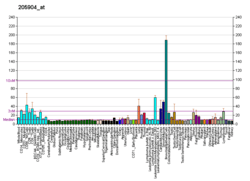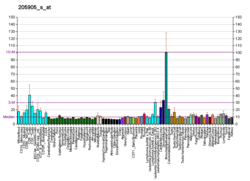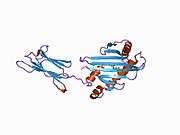MHC class I polypeptide-related sequence A
MHC class I polypeptide-related sequence A (MICA) is a cell surface glycoprotein encoded by the MICA gene located within MHC locus.[3] MICA is related to MHC class I and has similar domain structure, which is made up of external α1α2α3 domain, transmembrane segment and C-terminal cytoplasmic tail.[3] However, MICA is not associated with β2-microglobulin nor binds peptides as conventional MHC class I molecules do.[4] MICA rather functions as a stress-induced ligand for NKG2D receptor.[5] For example, the heat shock stress pathway is involved in the regulation of MICA expression as transcription of MICA is regulated by promoter heat shock element.[4] MICA is broadly recognized by NK cells, γδ T cells, and CD8+ αβ T cells which carry NKG2D receptor on their cell surface. As a result of NKG2D-MICA engagement, effector cytolytic responses of T cells and NK cells against epithelial tumor cells expressing MICA are initiated.[5]
See also
References
- 1 2 3 ENSG00000235233, ENSG00000204520, ENSG00000183214, ENSG00000233051 GRCh38: Ensembl release 89: ENSG00000231225, ENSG00000235233, ENSG00000204520, ENSG00000183214, ENSG00000233051 - Ensembl, May 2017
- ↑ "Human PubMed Reference:".
- 1 2 Bahram S, Bresnahan M, Geraghty DE, Spies T (Jul 1994). "A second lineage of mammalian major histocompatibility complex class I genes". Proceedings of the National Academy of Sciences of the United States of America. 91 (14): 6259–63. doi:10.1073/pnas.91.14.6259. PMC 44180. PMID 8022771.
- 1 2 Groh V, Bahram S, Bauer S, Herman A, Beauchamp M, Spies T (Oct 1996). "Cell stress-regulated human major histocompatibility complex class I gene expressed in gastrointestinal epithelium". Proceedings of the National Academy of Sciences of the United States of America. 93 (22): 12445–50. doi:10.1073/pnas.93.22.12445. PMC 38011. PMID 8901601.
- 1 2 Bauer S, Groh V, Wu J, Steinle A, Phillips JH, Lanier LL, Spies T (Jul 1999). "Activation of NK cells and T cells by NKG2D, a receptor for stress-inducible MICA". Science. 285 (5428): 727–9. doi:10.1126/science.285.5428.727. PMID 10426993.
Further reading
- Klein J, O'hUigin C (Jul 1994). "The conundrum of nonclassical major histocompatibility complex genes". Proceedings of the National Academy of Sciences of the United States of America. 91 (14): 6251–2. doi:10.1073/pnas.91.14.6251. PMC 44177. PMID 8022769.
- Bahram S, Spies T (Jun 1996). "The MIC gene family". Research in Immunology. 147 (5): 328–33. doi:10.1016/0923-2494(96)89646-5. PMID 8876061.
- Blumberg RS (Feb 1998). "Current concepts in mucosal immunity. II. One size fits all: nonclassical MHC molecules fulfill multiple roles in epithelial cell function". The American Journal of Physiology. 274 (2 Pt 1): G227–31. PMID 9486173.





